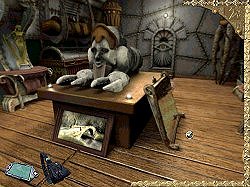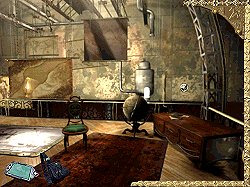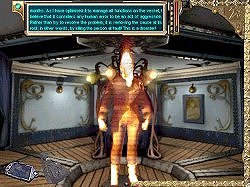|
The Secret of the Nautilus / Mystery of the Nautilus
 What starts with the promise of a rather enticing treatment of the famous Jules Verne novel, almost immediately becomes derailed by a search for some of the most minute hotspots ever encountered in a game, and one of the more messy game interfaces devised. That it manages to stay on track owes much to the subject matter of the game.
I suspect that Captain Nemo occupies a soft spot in the heart of many game players. I read numerous versions of the classic tale when I was much younger, and watched many a television show or movie modelled on, or borrowing from, the good Captain's adventures. I think I knew what a fathom was well before I knew about some other units of measurement, and plastic submarines and pretend giant squids were common place in my bathtubs and swimming pools.
The bottom of the sea also remains one of the world's great mysterious places, and my own scuba diving experiences only add to that mystery and wonder.
As such, I pressed on past the immediately apparent downsides of this game, and for most of the time was glad that I did.
Whilst on downsides, I will get another out of the way. The graphics look slightly fuzzy or out of focus, rather than sharp and clear. Which is a shame because there are some quite splendid scenes, and the detail in some of them is rich and sumptuous, apparently modelled on 19th century engravings. I confess I stopped noticing after a while, but it seemed odd given the visual clarity in many other games, including from Cryo. What starts with the promise of a rather enticing treatment of the famous Jules Verne novel, almost immediately becomes derailed by a search for some of the most minute hotspots ever encountered in a game, and one of the more messy game interfaces devised. That it manages to stay on track owes much to the subject matter of the game.
I suspect that Captain Nemo occupies a soft spot in the heart of many game players. I read numerous versions of the classic tale when I was much younger, and watched many a television show or movie modelled on, or borrowing from, the good Captain's adventures. I think I knew what a fathom was well before I knew about some other units of measurement, and plastic submarines and pretend giant squids were common place in my bathtubs and swimming pools.
The bottom of the sea also remains one of the world's great mysterious places, and my own scuba diving experiences only add to that mystery and wonder.
As such, I pressed on past the immediately apparent downsides of this game, and for most of the time was glad that I did.
Whilst on downsides, I will get another out of the way. The graphics look slightly fuzzy or out of focus, rather than sharp and clear. Which is a shame because there are some quite splendid scenes, and the detail in some of them is rich and sumptuous, apparently modelled on 19th century engravings. I confess I stopped noticing after a while, but it seemed odd given the visual clarity in many other games, including from Cryo.
 You play the part of a young oceanographer on deployment to the USS Shark, a military submarine exploring the ocean depths for signs of old civilisations or forgotten shipwrecks. The Shark locates a large metal object, and against the Captain's orders you take a submersible vehicle to explore the find. What has been found is the legendary Nautilus. You manage to get inside, but the hatch locks behind you, so the only way out is in.
The game takes place entirely within the Nautilus, and it is clear early on that this is no ordinary submarine. You will learn more as you go. But the first order of the day is to get past the short-circuiting door lock, and then move deeper into the ship.
This is essentially one big escape fest. You have to get out of the Nautilus. You must find ways to gain access to other parts of the submarine, which will require you to do mundane submarine type things like restoring power or fixing gear systems or opening the viewing windows. You will also have to overcome some not so submarine-like obstacles, predominantly the result of an inbuilt defence mechanism.
Many of the puzzles are of the find and gather the right items and use them in the right place type. Many are intuitive, some definitely tend towards the "try it because you have got it" variety. There is one of the latter type that you will not solve unless you do try everything, and there is one that is simply ludicrous, given what you will have learned about the consequences for your health of doing very small wrong things.
Some are timed, although you generally have plenty of that. There are some puzzles, though, where you may well die once or twice before working everything out, so save regularly. If you die, you have to restore from a save (there is no automatically returning you to the critical moment). There are 24 save game slots, and whilst I don't understand why saves have to be limited in number, 24 is more than enough. You play the part of a young oceanographer on deployment to the USS Shark, a military submarine exploring the ocean depths for signs of old civilisations or forgotten shipwrecks. The Shark locates a large metal object, and against the Captain's orders you take a submersible vehicle to explore the find. What has been found is the legendary Nautilus. You manage to get inside, but the hatch locks behind you, so the only way out is in.
The game takes place entirely within the Nautilus, and it is clear early on that this is no ordinary submarine. You will learn more as you go. But the first order of the day is to get past the short-circuiting door lock, and then move deeper into the ship.
This is essentially one big escape fest. You have to get out of the Nautilus. You must find ways to gain access to other parts of the submarine, which will require you to do mundane submarine type things like restoring power or fixing gear systems or opening the viewing windows. You will also have to overcome some not so submarine-like obstacles, predominantly the result of an inbuilt defence mechanism.
Many of the puzzles are of the find and gather the right items and use them in the right place type. Many are intuitive, some definitely tend towards the "try it because you have got it" variety. There is one of the latter type that you will not solve unless you do try everything, and there is one that is simply ludicrous, given what you will have learned about the consequences for your health of doing very small wrong things.
Some are timed, although you generally have plenty of that. There are some puzzles, though, where you may well die once or twice before working everything out, so save regularly. If you die, you have to restore from a save (there is no automatically returning you to the critical moment). There are 24 save game slots, and whilst I don't understand why saves have to be limited in number, 24 is more than enough.
 The Secret of the Nautilus is a fairly solitary game. Captain Nemo will appear now and then through a sort of holographic log, but other than the occasional automated response, that is pretty much it as far as companionship goes.
Your character will muse openly about things as you go, which can provide helpful clues to what is needed to be accomplished. This dialogue will pop up in the top left of screen, and then be recorded automatically in a Personal Digital Assistant (PDA). The PDA also contains other useful and some not so useful information and material. A real map of the corridors and rooms would have been far more useful than the drawings of the rooms themselves.
The Nautilus is a big place, and whilst the conundrums tend to be self contained in particular segments of the submarine, these sections can be quite large. Do not expect to find everything you need to achieve an objective in one place. You will have to explore all those parts of the submarine to which you have access, finding bits and pieces here and there.
You will find lots of things, but they will disappear from the inventory when they are no longer useful. You will also have to occasionally wear certain items, which you do simply by clicking the item on the small picture of your character in the inventory.
The game is played in the first person and you point and click your way around. Different well defined cursors will indicate that you can take or look at items, or that items can be used, and arrows indicate direction. You can speed up movement in the game, and turn subtitles on and off.
There is suitable ambient sound, and the music is excellent. It helped accentuate the solitude and the feeling of exploring the unknown, and heightened the tension in the critical sequences.
Whilst on the subject of music, I must mention that there is a mild music puzzle, which has visual cues to assist. To make you feel better, the responsible instrument ultimately gets its comeuppance. The Secret of the Nautilus is a fairly solitary game. Captain Nemo will appear now and then through a sort of holographic log, but other than the occasional automated response, that is pretty much it as far as companionship goes.
Your character will muse openly about things as you go, which can provide helpful clues to what is needed to be accomplished. This dialogue will pop up in the top left of screen, and then be recorded automatically in a Personal Digital Assistant (PDA). The PDA also contains other useful and some not so useful information and material. A real map of the corridors and rooms would have been far more useful than the drawings of the rooms themselves.
The Nautilus is a big place, and whilst the conundrums tend to be self contained in particular segments of the submarine, these sections can be quite large. Do not expect to find everything you need to achieve an objective in one place. You will have to explore all those parts of the submarine to which you have access, finding bits and pieces here and there.
You will find lots of things, but they will disappear from the inventory when they are no longer useful. You will also have to occasionally wear certain items, which you do simply by clicking the item on the small picture of your character in the inventory.
The game is played in the first person and you point and click your way around. Different well defined cursors will indicate that you can take or look at items, or that items can be used, and arrows indicate direction. You can speed up movement in the game, and turn subtitles on and off.
There is suitable ambient sound, and the music is excellent. It helped accentuate the solitude and the feeling of exploring the unknown, and heightened the tension in the critical sequences.
Whilst on the subject of music, I must mention that there is a mild music puzzle, which has visual cues to assist. To make you feel better, the responsible instrument ultimately gets its comeuppance.
I mentioned previously the messy game interface. There are several aspects to this, some being mere irritations, others though being more annoying.
The PDA and your inventory backpack are permanently visible in the left bottom corner or your screen. Move your cursor there to access either. Fairly straightforward, except that the game world pans through 360 degrees by moving the cursor to the edge of the screens. So if you move your cursor to access the PDA, the game world moves too. Alternatively, if you want to look down and to the left, you have to avoid the inventory or PDA with your cursor or else the view will freeze as the game thinks you want to access those items.
You will get the hang of things after a while, and you can limit the extent to which the game world inconveniently moves by moving your cursor quickly to the PDA (and avoid it altogether by right clicking for the inventory), but it is all so unnecessary.
You may also notice that the cursor migrates back to the centre of the screen when you close a dialogue box. To avoid shuttling the cursor back and forth when several boxes occur after each other, simply right click.
If you have your inventory open, you can't access the PDA. Nor can you move around with an inventory item in your hand. And I can't imagine why there is a gilt frame around the right edge of the game world.
From that gilt frame will occasionally appear a bar indicating your health, and invariably indicating that you are now involved in a sequence dangerous to that health. An assortment of dials will also appear, usually indicating the time left to achieve an objective.
For me this game was a mixed bag. Many hotspots are indeed tiny, so patience is more than just a virtue. It also dragged on at the end, where it tended to be very much an exercise in simply finding hotspots and trying everything. I certainly had no clear idea as to how to go about some of my apparent tasks. I think in fact the submerged rooms sequence (not too far from the end) was about where I had had enough.
Up until then though, I had rather enjoyed my efforts to escape. Even with its faults, The Secret of the Nautilus provided me with reasonable entertainment. And yes, there is a giant squid.
Copyright © Steve Ramsey, 2002.
All rights reserved.
System Requirements:
Windows 95 or above, PII 350 (PIII 450 recommended), 32 MB RAM (64 recommended), 8x CD ROM, DirectX 8.0a (on CD), 16 bit colour (24 recommended), Soundblaster compatible sound card.
|
